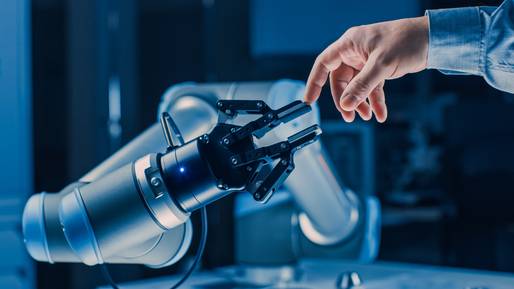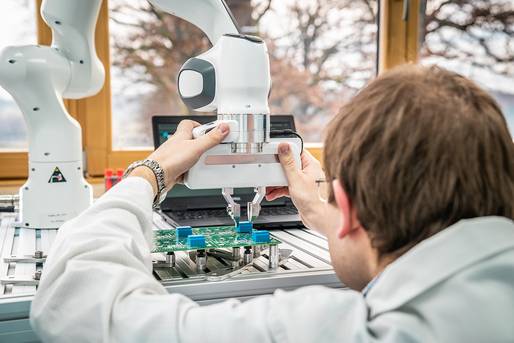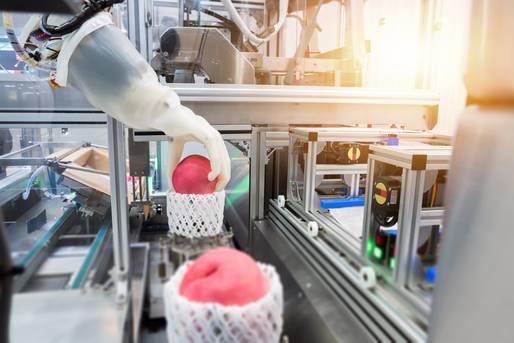Cobots » Collaborative robots as a gateway to automation
Updated: 10.11.2022 | Reading time: 5 minutes
This text is machine translated.
The industrial production of products is a new challenge for manufacturers every day. Especially when large quantities with maximum precision are required at a reasonable price. The introduction of the assembly line over 100 years ago was the first step in this direction. Thanks to its high efficiency, assembly line production has proven its worth in the automotive industry to this day.
Another major step towards efficient production was the introduction of ever-improving industrial robots. Industrial robots perform complex tasks such as cutting, welding or painting workpieces, for which skilled workers often require years of professional experience, much faster and with greater precision. Until now, however, the investment required for this was often only available to large companies and corporations.
With a collaborative robot, small and medium-sized companies can now also benefit from the advantages of automation without having to fear an explosion in costs.
We will be happy to explain how this works and where the advantages of collaborative robotics lie.
The term "cobot" is an artificial word made up of the words "collaboration" and "robot". Accordingly, the term cobot describes the direct interaction or collaboration between humans and robots. And this is precisely the crucial difference to the industrial robots mentioned at the beginning. These are only designed to stubbornly execute their pre-programmed motion sequences and therefore also operate in an area that is restricted to people.
Cobots, on the other hand, are articulated robots designed to actively support employees in their work. This means that humans and machines share the same workspace or work in the same spatial area depending on the activity. In this context, the term "HRC" is often used, an abbreviation for human-robot collaboration.
Collaborating robots are equipped with extensive sensor technology to enable close spatial cooperation. In combination with sophisticated software, the sensitive swivel-arm robots now react extremely intelligently to their environment.
In contrast to traditional industrial robots, which can be large, heavy and expensive, robotics with cobots offers decisive advantages. This is because HRC applications are much more extensive and involve far more than just pick-and-place tasks. For this reason, we have summarized the main advantages of cobot applications for you as examples.
Key advantages of using cobots
Practical benefits
Constantly recurring manual tasks, such as the precise cutting, milling or welding of components, can be carried out automatically more easily, quickly and cost-effectively. This frees up employees for other tasks and allows them to carry out quality control.
Cost advantage
In contrast to large industrial robots, cobots operate at a significantly lower price level. This means that even medium-sized or smaller companies can afford to purchase them. In addition, the period and runtimes until a cobot has fully amortized are significantly shorter than with expensive industrial robots.
Compact design
The compact design and interactive mode of operation mean that very little space is required. This means that collaborative robots can be integrated into the existing working environment relatively easily and without major conversion measures, taking into account applicable safety guidelines from the area of machine safety.
Flexible application options
A robot consists of a mechanical system that works with high precision and positioning accuracy. Thanks to the different joints, the movement sequences are very flexible and can be individually adapted to the work steps to be performed. In combination with different tools, the possible applications are almost limitless.
Extremely simple programming
The required movements are taught in via a touchscreen with a clear user interface and intuitive software. Alternatively, the teach-in process can be carried out by manually guiding the robot arm (hand-guiding). Classic programming is also possible for cross-system applications.
Increased effectiveness
All in all, the advantages listed lead to a significant increase in effectiveness. By using robots 24/7, companies are able to react much more flexibly to changing market situations. In contrast to competitors, they can also accept orders that would not be lucrative enough without automation.
Incidentally, in addition to stationary cobots, there are now also mobile robots on the market. These collaborative robots are extremely flexible in HRC applications, regardless of local restrictions. They can therefore be easily integrated into ongoing production or existing automation.
Manufacturers attach great importance to safety in HRC applications. This is because human-robot collaboration, i.e. direct cooperation between human colleagues and robots, involves a not inconsiderable risk of collision. After all, humans and machines work in the same action area. This is why cobot manufacturers equip their systems with extensive sensor technology. Force-torque sensors, proximity sensors and cameras in particular are frequently used in robotics.
As a result, collaborative robots are able to recognize danger and stop movement abruptly even before they actually come into contact with a person. A wide range of sensors are also available for the work tasks. This enables cobots to always grip with a precisely adapted amount of force
Irrespective of this, however, it is extremely important to train the people working in the cobot's area of operation in how to use the robot. The people concerned should be fully informed about the existing protective measures and safety equipment. This helps to ensure occupational safety and gives employees the necessary confidence in the technology of the HRC robot.
As already mentioned, cobots are designed as an economical automation solution for small to medium-sized enterprises (SMEs). The type of company (production or logistics) is initially irrelevant. Even craft businesses can benefit from robots. This is because cobots can be used to support people working on site as soon as tasks arise that require repetitive actions. We have listed some applications in more detail below:
Assembly activities
Cobots can be used in assembly lines for reliable screwing, sealing, gluing or welding.
Production activities
In production, cobots are suitable for precise cutting, grinding, deburring, polishing, marking or packaging.
Machine loading
For machine processing, cobots can insert the blanks into a machine and then remove them again.
Picking up and depositing
Robots provide valuable support for heavy workpieces that need to be moved for further processing.
Our practical tip: capacity utilization
Even if the work involved is not continuous due to limited quantities or small batches, the helpful robots are certainly a worthwhile purchase. In contrast to industrial robots, which often only ever perform the same motion sequence over their entire service life, collaborative robots can be easily and quickly adapted to a wide variety of tasks .
At the moment, both cobots for automation and HRC are an absolute hot topic. More and more companies are recognizing the enormous potential offered by the use of robots in automation. For this reason, manufacturers such as Universal Robots, ABB, Kuka, Bosch Rexroth, Franka Emika, Kassow Robots, LBR iiwa, Rethink Robotics, TM Roboter and Yuanda Robotics are bringing more and more models onto the market. And the different systems are just as diverse as the manufacturers. This makes it difficult to find the right cobot for the planned application. This is because the information on the portable load (payload) or the required reach is far from sufficient.
Another option for finding the right cobot is to use our cobot decision aid. This is ideal if you already have an idea but are still unsure which model meets your requirements. You can reach a possible decision by answering 11 questions.





